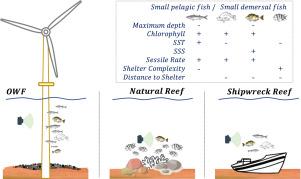使用光学方法调查人工和自然珊瑚礁中潜在的鱼类分布:来自亚热带海上风力发电场的见解
IF 2.3
2区 农林科学
Q2 FISHERIES
引用次数: 0
摘要
以实现清洁能源和绿色转型为目标,海上风电场在全球范围内迅速建立。外湾渔场的水下桩基已显示出用作人工鱼礁的潜力。为了探讨亚热带生态系统的生态效益,研究了两个海洋生物保护区、附近的一个自然礁和一个沉船礁的鱼类分布情况。研究人员开发了一种低成本的光学方法来收集鱼类数据,然后利用深度学习技术从水下视频中识别出四种目标物种。为了重建从海面到海底的分布模式,根据相机视图沿记录路径计算鱼类密度。鱼类聚集主要表现为圆鳞(0.025-0.26 / m3)和棘足(0.052-0.15 / m3)的高密度。在整个垂直水柱中,在单个风力涡轮机基础附近观察到目标鱼群,中间水层的聚集程度更高。黑色刮刀在沉船礁处密度最高(0.024 / m3)。自然礁区以小雀为主(0.055 ~ 0.14只/ m3);然而,在附近的自由渔场或沉船礁却很少发现人工鱼礁,说明人工鱼礁的生态功能可能无法完全覆盖天然鱼礁。多元回归分析表明,鱼类可能对结构特征和环境变量表现出特定的偏好。这项研究提供了潜在鱼类分布的见解,为当地管理人员和钓鱼爱好者提供信息,同时支持海洋自由渔场的可持续发展,并为海洋保护工作做出贡献。本文章由计算机程序翻译,如有差异,请以英文原文为准。

Investigating potential fish distributions in artificial and natural reefs using an optical method: Insights from subtropical offshore wind farms
With the goal of achieving clean energy and green transition, offshore wind farms (OWFs) have been rapidly established worldwide. The underwater pile foundations in OWFs have shown potential to serve as artificial reefs. To explore the ecological benefits in subtropical ecosystems, fish distributions were investigated at selected sites: two OWFs, a nearby natural reef, and a shipwreck reef. A low-cost optical method was developed to collect fish data, followed by deep learning techniques to identify four target species from underwater videos. To reconstruct distribution patterns from the sea surface to the bottom, fish densities were calculated along the recording path based on the camera view. In the OWFs, fish aggregation was confirmed by the high densities of round scad (0.025–0.26 per m) and spinefoot (0.052–0.15 per m). The target fish groups were observed near the individual wind turbine foundations throughout the entire vertical water column, with higher aggregation in the mid-water layers. Black scrapers exhibited the highest density at the shipwreck reef (0.024 per m). Damselfish were dominant at the natural reef area (0.055–0.14 per m); however, they were rarely found at the nearby OWF or shipwreck reef, indicating that the ecological function of artificial reefs may not fully cover that of natural reefs. Multiple regression analysis showed that the fish may exhibit specific preferences for structural features and environmental variables. This study provides insights into potential fish distributions to inform local managers and fishing enthusiasts, while supporting sustainable OWF development and contributing to marine conservation efforts.
求助全文
通过发布文献求助,成功后即可免费获取论文全文。
去求助
来源期刊

Fisheries Research
农林科学-渔业
CiteScore
4.50
自引率
16.70%
发文量
294
审稿时长
15 weeks
期刊介绍:
This journal provides an international forum for the publication of papers in the areas of fisheries science, fishing technology, fisheries management and relevant socio-economics. The scope covers fisheries in salt, brackish and freshwater systems, and all aspects of associated ecology, environmental aspects of fisheries, and economics. Both theoretical and practical papers are acceptable, including laboratory and field experimental studies relevant to fisheries. Papers on the conservation of exploitable living resources are welcome. Review and Viewpoint articles are also published. As the specified areas inevitably impinge on and interrelate with each other, the approach of the journal is multidisciplinary, and authors are encouraged to emphasise the relevance of their own work to that of other disciplines. The journal is intended for fisheries scientists, biological oceanographers, gear technologists, economists, managers, administrators, policy makers and legislators.
 求助内容:
求助内容: 应助结果提醒方式:
应助结果提醒方式:


